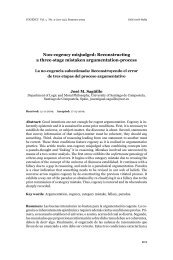Cogency v2 n2
Cogency v2 n2
Cogency v2 n2
You also want an ePaper? Increase the reach of your titles
YUMPU automatically turns print PDFs into web optimized ePapers that Google loves.
COGENCY Vol. 2, N0. 2, Spring 2010<br />
ated by the aptness of an image, but unlike the puzzle piece, which we fit<br />
into a context, seeing an aspect is like understanding how to fit the other<br />
pieces around a piece that we have decided to use for an anchor. It is, as<br />
Seligman puts it, “a kind of ‘knowing one’s way about’.” The important point<br />
to take away from this notion of “seeing as,” is that to see a visual image as<br />
having a particular aspect is not to pull out a hidden signification that lies<br />
within it, the way that a creature’s DNA lies within its cells. It is to attach a<br />
significance to the image through the positing of counterfactuals that frame<br />
the image in such a way as to make it possible for us to explain to others the<br />
aspect we ourselves see.<br />
This completes the sketch of Wittgenstein’s notion of picturing. Though<br />
undoubtedly there is a great deal more to say about such matters, the sketch<br />
in its present form should suffice for purposes of application to the question<br />
of whether or not there can be purely visual arguments.<br />
4. Picturing, Visual Arguments, and Visual Argumentation<br />
It shall be my contention in this portion of the paper to show that while no<br />
one has yet satisfactorily shown that there are visual arguments, this does<br />
not rule out the possibility that visual images can be elements of argumentation.<br />
10 The account of picturing left to us by Wittgenstein, I shall content,<br />
can shed some light as to why this is. Because visual argumentation theories<br />
are so varied I cannot address them all, so I shall here confine myself to<br />
two of the better-known accounts of recent years, the interesting and very<br />
different theories put forward by the team of David Birdsell and Leo Groarke,<br />
and that of Christina Slade.<br />
4.1. Birdsell and Groarke<br />
Perhaps the best known view of visual argument is that provided by Birdsell<br />
and Groarke (1996, 2002). As is well known Birdsell and Groarke quite ex-<br />
10<br />
In this I am siding, I believe, with Blair (1996), though perhaps in a different way and<br />
for different reasons.<br />
118








